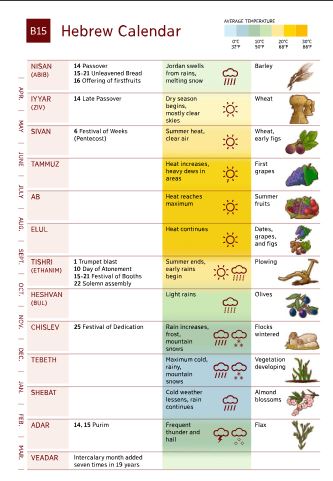ancient,calendar,Chankillo,ancient astronomical observatory,thirteen towers ,tracena,calendar mesoamerica
Chankillo - an ancient astronomical observatory. Includes a much older calendar system consistent with the biblical narrative of the spring equinox (14 Abib later Nisan) and the date of August 9 corresponding to the destruction of Jerusalem by the Babylonian army in 607 BC 
 [Diagram] 1 st NISAN (ABIB) March - April 14 Passover 15-21 Unfermented Cakes 16 Offering of firstfruits Barley 2nd IYYAR (ZIV) April - May 14 Late Passover (Nu 9: 10-13) Wheat 3rd SIVAN May - June Festival of Weeks (Pentecost) Early Figs 4th TAMMUZ June - July First Grapes 5th AB July - August Summer Fruits 6th ELUL August - September Dates, Grapes, Figs 7th TISHRI September - October 1 Trumpet blast 10 Day of Atonement 15-21 Festival of Booths or Ingathering 22 Solemn assembly Plowing 8th HESHVAN (BUL) October - November Olives 9th CHISLEV November - December 25 Festival of Dedication Flocks Wintered 10th TEBETH December - January Vegetation Developing 11th SHEBAT January - February Almond Blossoms 12th ADAR February - March Archaeological evidence indicates that Chankillo may be the earliest known astronomical observatory in the Americas. Built over 2,300 years ago, the site includes a temple, a plaza, and thirteen towers constructed from cut stone. The complex lies in the coastal desert of Peru near the Casma-Sechín river basin. Recent excavations indicated that Chankillo was occupied for a relatively short period of time between the mid-fourth century BC and the early first century AD but was subsequently abandoned, most likely due to violent conflict. In 2007, Chankillo was identified as an early astronomical observatory. Chankillo is unique among ancient observatory sites because of its multiple observation points;similar sites around the world contain only one point of astronomical alignment, which does not provide the measurements needed to track the passage of time over a full year. The thirteen towers of Chankillo, situated between two observation platforms, span the entire annual rising and setting arc of the sun, which gradually shifts along the horizon over the course of a year. The inhabitants of Chankillo would have been able to determine the date with an accuracy of two to three days by watching the sunrise or sunset from the correct observation platform. Using the site as an observatory would have allowed the inhabitants to regulate the occurrence of seasonal events, including planting and harvest times, as well as religious festivals.The archaeological evidence at Chankillo suggests that sun worship existed in the Andes around two millennia before the well-known sun cult of the Inca Empire. -https: //www.wmf.org/project/chankillo Chankillo:
[Diagram] 1 st NISAN (ABIB) March - April 14 Passover 15-21 Unfermented Cakes 16 Offering of firstfruits Barley 2nd IYYAR (ZIV) April - May 14 Late Passover (Nu 9: 10-13) Wheat 3rd SIVAN May - June Festival of Weeks (Pentecost) Early Figs 4th TAMMUZ June - July First Grapes 5th AB July - August Summer Fruits 6th ELUL August - September Dates, Grapes, Figs 7th TISHRI September - October 1 Trumpet blast 10 Day of Atonement 15-21 Festival of Booths or Ingathering 22 Solemn assembly Plowing 8th HESHVAN (BUL) October - November Olives 9th CHISLEV November - December 25 Festival of Dedication Flocks Wintered 10th TEBETH December - January Vegetation Developing 11th SHEBAT January - February Almond Blossoms 12th ADAR February - March Archaeological evidence indicates that Chankillo may be the earliest known astronomical observatory in the Americas. Built over 2,300 years ago, the site includes a temple, a plaza, and thirteen towers constructed from cut stone. The complex lies in the coastal desert of Peru near the Casma-Sechín river basin. Recent excavations indicated that Chankillo was occupied for a relatively short period of time between the mid-fourth century BC and the early first century AD but was subsequently abandoned, most likely due to violent conflict. In 2007, Chankillo was identified as an early astronomical observatory. Chankillo is unique among ancient observatory sites because of its multiple observation points;similar sites around the world contain only one point of astronomical alignment, which does not provide the measurements needed to track the passage of time over a full year. The thirteen towers of Chankillo, situated between two observation platforms, span the entire annual rising and setting arc of the sun, which gradually shifts along the horizon over the course of a year. The inhabitants of Chankillo would have been able to determine the date with an accuracy of two to three days by watching the sunrise or sunset from the correct observation platform. Using the site as an observatory would have allowed the inhabitants to regulate the occurrence of seasonal events, including planting and harvest times, as well as religious festivals.The archaeological evidence at Chankillo suggests that sun worship existed in the Andes around two millennia before the well-known sun cult of the Inca Empire. -https: //www.wmf.org/project/chankillo Chankillo:
[VIDEO] youtu.be/q13Pz-R8OuE [/ VIDEO]
June 21
June 31
August 12
August 23
September 2
September 11
September 22
October 1
October 11
October 20
October 30
November 12
November 28
December 21
January 10
January 27
February 9
February 19
March 1
March 11
March 21
March 31
April 10
April 20
May 2
May 14
June 21
______________________________________
June 21
July 24
August 9
August 21
September 1
September 12
September 23
October 4
October 16
October 28
November 3
November 18
December 6
January 2
January 20
February 4
February 11
February 23
March 7
March 19
March 30
April 11
April 23
May 5
May 21
June 21
[Modificato da rodz2015 24/11/2020 07:55]